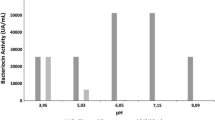Abstract
A wild Lactobacillus plantarum strain and two of its plasmid-cured derivatives were separately used as adjunct cultures in the manufacture of a Gouda-like traditional Spanish cheese. The wild strain, LL441, harbours seven plasmids and produces a lantibiotic-like bacteriocin. The LL441-B2 derivative has lost plasmids of 40 and 80 kb and the bacteriocin-producing capability. The LL441-B11 derivative has lost in addition a 70 kb plasmid encoding active α- and β-galactosidases. All three strains could be used as adjunct cultures as none of the technological and biochemical parameters of the cheeses was affected. Both the wild-type and the two derivatives were recovered from experimental cheeses up to 30 days after manufacture at similar rates of nearly 20%. Thus, the phenotypic traits under examination were not essential for L. plantarum to grow into the cheese matrix.
Similar content being viewed by others
References
Anderson DG, McKay LL (1983) Simple and rapid method for isolating large plasmid DNA from lactic streptococci. Appl Environ Microbiol 46:549–552
AOAC (1984) William S (ed) Official Methods of Analysis of the Association of Official Analytical Chemist, 14th edn. AOAC, Arlington, Va.
Beresford TP, Fitzsimons NA, Brennan NL, Cogan TM (2001) Recent advances in cheese microbiology. Int Dairy J 11:259–274
Crow V, Curry B, Hayes M (2001) The ecology of non-starter lactic acid bacteria (NSLAB) and their use as adjuncts in New Zealand Cheddar. Int Dairy J 11:275–283
Estepar MJ, Sánchez MM, Alonso L, Mayo B (1999) Biochemical and microbiological characterization of Peñamellera cheese: analysis of its indigenous lactic acid bacteria. Int Dairy J 9:737–746
Fernández M, Margolles A, Suárez JE, Mayo B (1999) Duplication of the β-galactosidase gene in some Lactobacillus plantarum strains. Int Dairy J 48:113–123
Fox PF, McSweeney PLH, Lynch CM (1998) Significance of non-starter lactic acid bacteria in Cheddar cheese. Aust J Dairy Technol 53:83–89
Gómez MJ, Gaya P, Núñez M, Medina M (1996) Effect of Lactobacillus plantarum as adjunct starter on the flavour and texture of a semi-hard cheese made from pasteurized cow's milk. Lait 76:461–472
González B, Arca P, Mayo B, Suárez JE (1994) Detection, purification, and partial characterization of plantaricin C, a bacteriocin produced by a Lactobacillus plantarum strain of dairy origin. Appl Environ Microbiol 60:2158–2163
Khalid NM, Marth EH (1990) Lactobacilli, their enzymes and role in ripening and spoilage of cheese: a review. J Dairy Sci 73:2669–2684
Lane CN, Fox PF (1996) Contribution of starter and adjunct lactobacilli to proteolysis in Cheddar cheese during ripening. Int Dairy J 6:715–728
Martley FG, Crow VL (1993) Interactions between non-starter organisms during cheese manufacturing and ripening. Int Dairy J 3:461–483
McSweeney PLH, Fox PF, Lucey JA, Jordan KN, Cogan TM (1993) Contribution of the indigenous microflora to the maturation of Cheddar cheese. Int Dairy J 3:613–634
Peterson SD, Marshall RT, Heymann H (1990) Peptidase profiling of lactobacilli associated with Cheddar cheese and its application to identification and selection of strains for cheese-ripening studies. J Dairy Sci 73:1454–1464
Vuyst L de, Vandamme E (1994) Antimicrobial potential of lactic acid bacteria. In: de Vuyst L, Vandamme E (eds) Bacteriocins of lactic acid bacteria. Blackie, London, pp 91–142
Williams AG, Banks JM (1997) Proteolytic and other hydrolytic enzyme activities in non-starter lactic acid bacteria (NSLAB) isolated from Cheddar cheese manufactured in the United Kingdom. Int Dairy J 7:763–774
Acknowledgements
This work was supported by the Comisión Interministerial de Ciencia y Tecnología (CICYT), (Grant 97FD-0339). The authors thank the firm SCL Quesos de Peñamellera, which kindly offered its facilities for experimental trials. The skilful assistance of M.J. González is gratefully acknowledged.
Author information
Authors and Affiliations
Corresponding author
Rights and permissions
About this article
Cite this article
Delgado, S., Mayo, B. Development of Lactobacillus plantarum LL441 and its plasmid-cured derivatives in cheese. J IND MICROBIOL BIOTECHNOL 30, 216–219 (2003). https://doi.org/10.1007/s10295-003-0041-5
Received:
Accepted:
Published:
Issue Date:
DOI: https://doi.org/10.1007/s10295-003-0041-5




